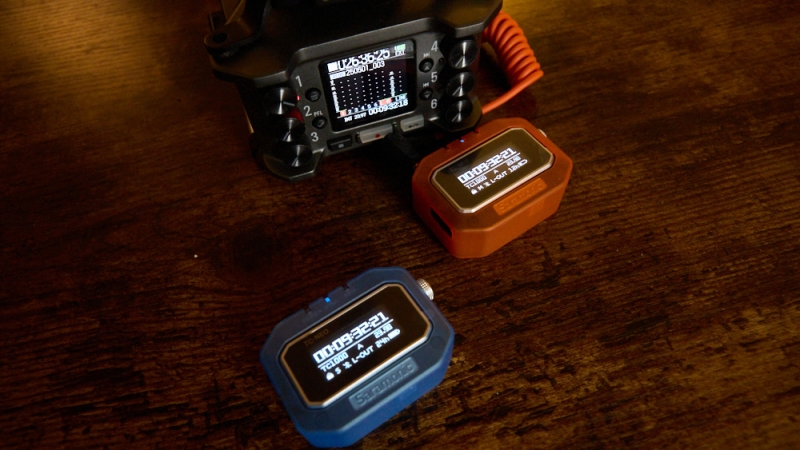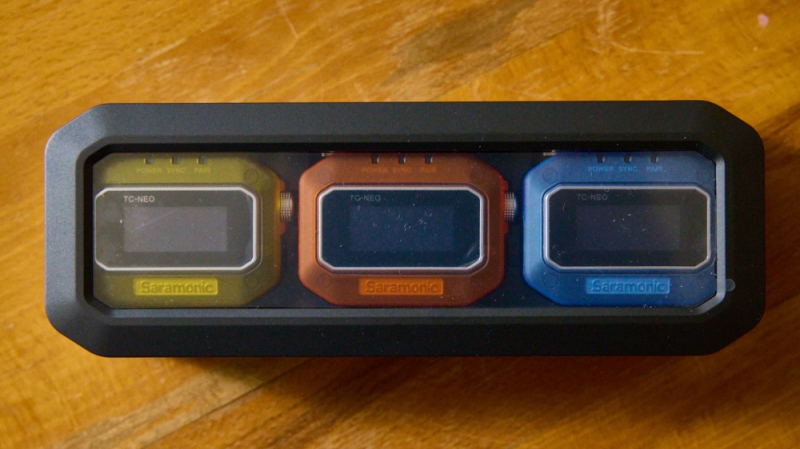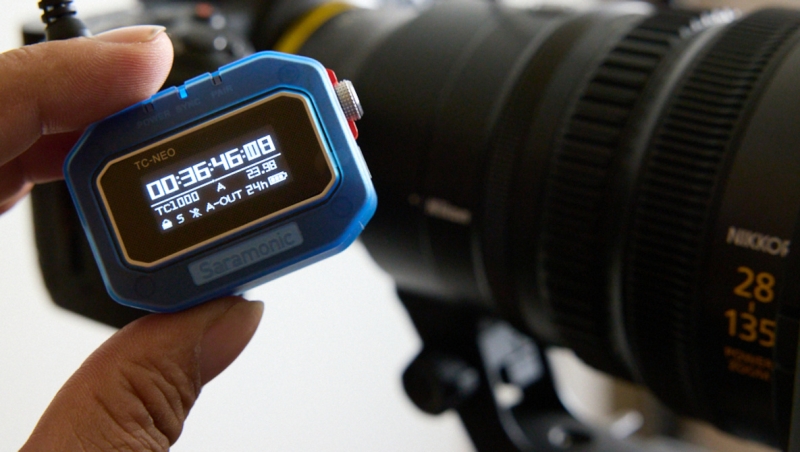Today, we’ll have a look at the new Saramonic TC-NEO wireless timecode generator.
Last semester, I taught a course on filmmaking at a local college. It’s always fun discussing exposure, composition, lighting, and all the rest of the wonderful and exciting tools we have at hand as filmmakers. But, of course, filmmaking isn’t all imagination and playing with fun tools. Most of it is paying painstaking attention to the small details that will determine whether your production sinks or swims—or, at a bare minimum, exactly how crazy you’re going to drive yourself by the time you get to post.
Timecode isn’t a particularly sexy topic, but it is vitally important. Just ask the sound mixer on a project I shot last year where the timecode wasn’t functioning properly. It can be the difference between post being a breeze and post being a nightmare.
A quick recap for those of you who don’t know what timecode is: in the simplest terms, timecode is a crystal-synced running clock that marries itself to your video footage. Broken down into hours, minutes, seconds, and frames, it records the exact moment in time that relates to an exact frame of video. This is not always the exact same as the time of day. Rather, this is a specific time system that relates to recording your film or video.
Why is this important? Well, because sound for professional film and video is usually recorded separately from video, there needs to be a way to reliably line up the exact time of video that relates to the exact time of sound. They need to be synchronized so that sound matches picture. You do this by making sure they are both running identical synchronized timecode. Similarly, if you are using multiple cameras, the same thing would apply. You’d want all your cameras and all your sound devices pointed to the identical timecode so that you can link them up easily in post without having to manually synchronize every word out of a character’s mouth. I’ve had to do that before. It’s not fun. Trust me, reliable timecode is a much better way to go.

So how do we accomplish this? Well, that’s where something like the Saramonic TC-NEO comes in. It’s a small device that generates timecode that you can then connect to your camera or sound devices to burn into the metadata (or record as a reference track if your camera doesn’t have proper timecode ports). If you have more than one TC-NEO, you can synchronize each of them, then connect them to multiple devices to ensure all of your tools are working in synchronization.
The kit I got to try out was the Saramonic TC-NEO Kit with three generators set to work together. The system produces SMPTE LTC/ATC timecode output with Bluetooth 5.0 and 2.4 GHz wireless sync. It has three modes, which include Master Run, Auto Jam, and Jam Once Then Lock. The kit came with three locking cables to allow you to connect to a number of devices, from mirrorless cameras to full cinema bodies. It also includes a series of cold shoe mounts to help easily keep your system compact. As someone with a tendency to beat the living crap out of my gear, I appreciated the well-organized charging case that the three-unit kit arrives in. This allows you to keep organized while also charging all of your units simultaneously on the go. I also like that the three units are different colors, which makes them easy to identify on set. The Saramonic System app, available on both Android and iPhone, allows you to control your devices up to 250 feet away.
Of course, when it comes to timecode devices, there’s really only one question: do they work? I brought the devices onto a recent multi-cam shoot with me where I was running two mirrorless cameras alongside an external audio field recorder. I synchronized the devices, then used them to jam sync the timecode for the duration of the shoot.
It’s hard to really illustrate proper timecode functionality. It’s not like a high-megapixel file you can zoom into to show detail. Rather, having great timecode is like having a great offensive lineman in the NFL. You mostly notice it when the device screws up. Otherwise, its job is to go unnoticed. And, in this case, the TC-NEO kit performed as promised.
The three units in the kit were easy to synchronize. I also had an individual unit, which was equally easy to synchronize with the main master, so I actually had four units running simultaneously. The units can both put out and receive a jam sync, so combining it with other timecode devices should work well.

The three color coded generators in the power case. You can charge all of them simultaneously within the case.
If you are considering playing with this generator, I will mention one hiccup I had that you should be aware of. It’s a man-made one, so not necessarily a knock on the generator itself. But the instructions in the kit could be a bit clearer, as it took me an embarrassingly long amount of time to figure this out.
First, I should say that while it’s nice that modern gear always wants to connect to my phone via an app, in the field I would far prefer to be able to use my tools in a tactile fashion rather than have to keep pulling my phone out to control them. Thankfully, the TC-NEO gives you that option with a fairly simple button and jog wheel setup that allows you to change things on the fly.
Where I got tripped up is that, out of the box, the units go into lock mode automatically. This is good, as it keeps you from disrupting your timecode during a shot. But, for the absolute life of me, I couldn’t figure out how to get the unit unlocked in order to change the frame rate and other settings. It was clear that double pressing the dial would get me the menu. But I couldn’t get to the menu because I couldn’t figure out how to unlock it. So I spent a very long time just trying to figure that out.
Turns out all you have to do to unlock it is to triple-click the power button. Then, you double-click the dial. But you have to do it in that sequence. As I said, not a knock on the system’s performance. But knowing that ahead of time would have saved me a lot of time, so I wanted to save you some.
Once I got over that hurdle, everything was pretty intuitive. Most everything is controlled with that dial, which can be spun or pressed. The menu is easy to understand. Although, again, the lock icon could use a little work, as the minute difference between it appearing locked and unlocked contributed to my earlier issue and could easily trip up a lot of thick eyeglass-wearing folks like myself. Battery life is strong. The menu has a handy indicator that tells you how much juice you have left. The information on the menu screen is simple, clean, and easy to follow.
Pros
- Small size
- Easy to link together
- Compatible with other timecode generators
- Simple design
- Convenient charging case
Cons
- The lock/unlock icon
Conclusion
Coming in at $499 for the three-unit kit or $149 for a standalone unit, the TC-NEO is a useful tool for all filmmakers. Even if you aren’t yet at the level where you feel as though you need to utilize timecode in your workflow, it’s always good practice to get into the habit of capturing perfectly synchronized media assets on set. You never know when that little personal project you shot is suddenly going to need to be run through a major post house, and it pays to be prepared.

